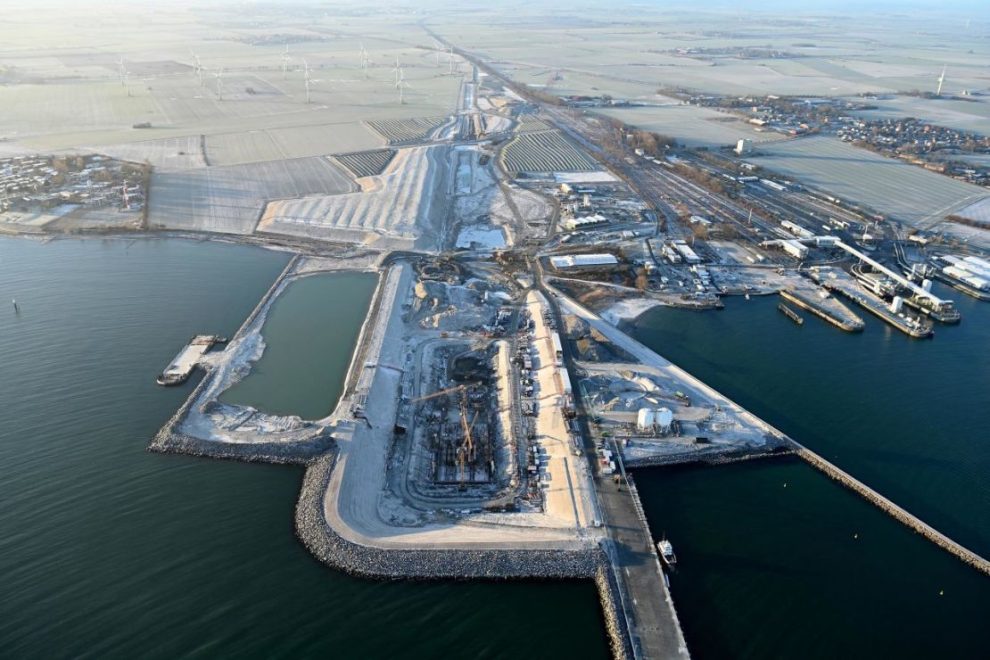() – Descent up to 40 meters under the Baltic Sea, the world’s longest submerged tunnel will link Denmark and Germany, drastically reducing journey times between the two countries once it opens in 2029.
The first element of the Fehmarnbelt tunnel was inaugurated on June 17 by King Frederick
On the Danish side, east of Rødbyhavn, the factory that will build the 89 huge concrete sections that will form the tunnel was completed last year. Fermern A/S, the Danish state-owned company in charge of the project, says it is the largest and most advanced production facility of its kind.
The tunnel, which will be 18 kilometers long, is one of the largest infrastructure projects in Europe, with a construction budget of more than 7 billion euros.
For comparison, the 50-kilometer Channel Tunnel linking England and France, completed in 1993, cost the equivalent of 12 billion pounds ($13.6 billion) in today’s money. Although longer than the Fehmarnbelt tunnel, the Channel Tunnel was built with a boring machine, rather than submerging already constructed tunnel sections.
The tunnel will be built through the Fehmarn Belt, a strait between the German island of Fehmarn and the Danish island of Lolland, and is intended as an alternative to the current ferry service between Rødby and Puttgarden, which carries millions of passengers a year. While the crossing now takes 45 minutes by ferry, it will only take seven minutes by train and 10 minutes by car.
The tunnel, officially named Fehmarnbelt Fixed Link, will also be the longest combined road and rail tunnel in the world. It will consist of two dual-lane highways separated by a service crossing and two electric railway tracks.
“Today, if you took a train trip from Copenhagen to Hamburg, it would take about four and a half hours,” said Jens Ole Kaslund, technical director of Femern A/S, in 2022. “When the tunnel is finished, the same trip will take two hours and a half.
“Now many people fly between the two cities, but in the future it will be better to just take the train,” he adds. The same car trip will be about an hour faster than today, taking into account the time saved by not queuing for the ferry.
In addition to the benefits for passenger trains and vehicles, the tunnel will have a positive impact on trucks and freight trains, according to Kaslund, because it creates a land route between Sweden and Central Europe that will be 160 kilometers shorter than the existing one in the present.
For now, traffic between the Scandinavian peninsula and Germany via Denmark can take the ferry across the Fehmarnbelt or a longer route via bridges between the islands of Zeeland, Funen and the Jutland peninsula.
The project dates back to 2008, when Germany and Denmark signed a treaty to build the tunnel. Then we had to wait more than a decade for both countries to approve the necessary legislation and to carry out the geotechnical and environmental impact studies.
While the process was completed without a hitch on the Danish side, in Germany several organizations, including ferry companies, environmental groups and local municipalities, appealed against the approval of the project, citing unfair competition or environmental and noise problems.

In November 2020, a German federal court dismissed the claims. “The ruling came with a series of conditions, which we sort of expected and were prepared for, about how to keep an eye on the environment while we build, about things like noise and the dumping of sediment. I think we need to make sure that the environmental impact is as small as possible,” said Henrik Vincentsen, CEO of Femern A/S, in 2022.
There are other phases of the project underway, such as excavation of the trench that will house the tunnel. Each section will be 217 meters long (about half the length of the world’s largest container ship), 42 meters wide and 9 meters high. Weighing 73,000 metric tons each, they will be as heavy as more than 13,000 elephants.
The factory has three warehouses and six production lines. The sections will be placed just below the seabed, about 40 meters below sea level at the deepest point, and moved into place by barges and cranes. Placing the sections will take about three years.

Up to 2,500 people will work directly on the construction project. Michael Svane of the Confederation of Danish Industry, one of Denmark’s largest business organizations, told in 2022 that he believes the tunnel will benefit companies in other countries.
“The Fehmarnbelt tunnel will create a strategic corridor between Scandinavia and Central Europe. Improving rail transshipment means more goods will move from road to rail, supporting a climate-friendly mode of transport. We consider cross-border connections to be a tool to create growth and jobs not only locally, but also nationally,” he declared.

Although some environmental groups have expressed concern about the tunnel’s impact on porpoises in the Fehmarn belt, Michael Løvendal Kruse of the Danish Society for Nature Conservation believes the project will have environmental benefits.
“As part of the Fehmarnbelt tunnel, new natural areas and stone reefs will be created on the Danish and German sides. Nature needs space and, as a result, there will be more space for nature,” he says.
“But the biggest advantage will be the benefit to the climate. The faster pace will result in trains becoming a strong rival to air traffic, and charging on electric trains is by far the best solution for the environment.”














Add Comment